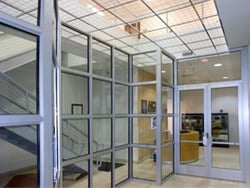Over the past two years a number of “personal bullet proof shield” products have been heavily promoted as a low-cost school safety solution. These have ranged from “bullet proof” white boards and blankets to a variety of small fiberglass inserts intended to make any backpack or briefcase “bullet proof.” These products are generally made from legitimate UL-rated bullet resistant materials. But just putting pieces of ballistic fiberglass in the classroom doesn’t magically prevent injuries. You increase school safety by integrating bullet resistant materials into a comprehensive security design that stops incidents before they happen.
Foot-Pounds vs. Backpacks
A basic Level 1 ballistic barrier system is designed to stop three shots from a 9mm pistol. In practice, it’s not uncommon for a Level 1 bullet resistant barrier to stop a dozen or more bullets. But that doesn’t mean that slipping a 1/4 or 1/2 inch thick fiberglass panel into a child’s backpack will keep them safe.
Consider that 9mm bullet. It weighs just 7 or 8 grams–about as much as a fifty-cent piece–and is smaller than the tip of your pinkie finger. But it travels nearly 1,300 feet per second, delivering at least 300 foot-pounds of energy on impact. That’s roughly as much energy as it takes to fling a cinderblock over a house.
A bullet resistant panel integrated into a UL-rated ballistic barrier can withstand bullet after bullet after bullet because it’s able to disperse the energy of each impact into the building’s structure. Without the underlying stud walls, that bullet proof panel has no way to disperse the energy. The bullet is stopped; the energy is not. “It’s tough to hold a piece of bullet proof fiberglass when it gets shot,” Total Security Solutions CEO Jim Richards notes. “And that’s apart from the realities of being in an emergency situation, which is extremely chaotic.”
You Can’t Stick Comprehensive Security in Your Backpack or Briefcase
“You need a comprehensive security approach,” Jim explains, “It’s not just about what you do if someone comes into a classroom shooting. That’s very late in the game. It’s about controlling access before anyone even gets to the door. It’s about knowing what door is open when, and having processes in place to control how people move through the building.”
Comprehensive security includes both structural enhancements–like bullet resistant doors and reinforced entryways–and good building management practices. There are plenty of unarmed people who should not be making unscheduled contact with students. A random chunk of fiberglass will not protect students from them. But a secured ballistic vestibule will. The same shelter-in-place strategy that protects students from an active shooter also protects them from flying debris during a tornado. Containing an active shooter and evacuating a building is no different from containing a fire and clearing the halls. Good security doesn’t address a specific threat; it enhances readiness and decreases the deadliness of any disaster.
Next Steps:
- Sign up for our newsletter to stay up-to-date about future trade show appearances
- Download our Company Overview to learn more about Total Security Solutions
- Connect with us on Linkedin, Facebook, or Twitter


